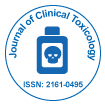
Journal of Clinical Toxicology
Open Access
ISSN: 2161-0495

ISSN: 2161-0495
Baragamaarachchi R Y1, Weearasena O V D S J1, Handunnetti S M1 and Samarasekara R2
Scientific Tracks Abstracts: J Clin Toxicol
Comet assay is a very sophisticated technique use to assess plethora of DNA damages at the level of individual cells and can be
applied in a range of fields from human and environmental biomonitoring, routine genotoxicity assessment, DNA repair studies,
and clinical studies to molecular epidemiology. Due to its demonstrated advantages and applications it is increasingly acceptable by
regulatory authorities as a part of battery of assays used for regulatory submissions in genetic toxicology. Yet the major drawback of
this technique is the unreliability in making reproducible data, due to miscellaneous conditions used in different laboratories and
due to lack of understanding of the critical steps. Comet assay was performed according to the protocol described by Raymond
Tice, with some modifications. Some critical steps that affect the final outcome of the assay were optimized during thisstudy. As the
concentration of low melting agarose greatly influenced the comet formation and assay reproducibility, melting of agarose in a boiling
water bath was found to be better than melting using a microwave oven. Optimal agarose solidification time was 30 min at 4°C to
attain adequately solidified agarose layers which reduce the fragility. Optimal lysis time was 2 h at 4°C. Alkaline unwinding time was
increased up to 30 min for adequate denaturation of DNA. The best way to calculate the required voltage to get a voltage drop of 1
V/cm, was to use the spreadsheet developed by Gunnar Brunborg. Electrophoresis for 45 min was found to be sufficient to obtain a
considerable DNA migration. However, a small factor, that one would not consider, significantly matters the final outcome and the
assay reproducibility.
Baragamaarachchi R Y is a first year PhD student who graduated with a first class in BSc Genetics from University of Bangalore. She obtained MSc in Molecular Life
Sciences in 2014 from University of Colombo, Sri Lanka. Her research interests lie in Molecular Biology, Immunology, Medicinal plants, Genetics and Microbiology. She has
served as a resource person at workshops based on Immunological techniques and awarded at 2nd International Conference on Frontiers in Molecular Life Sciences held
in Sri Lanka (2014), for outstanding poster presentation.